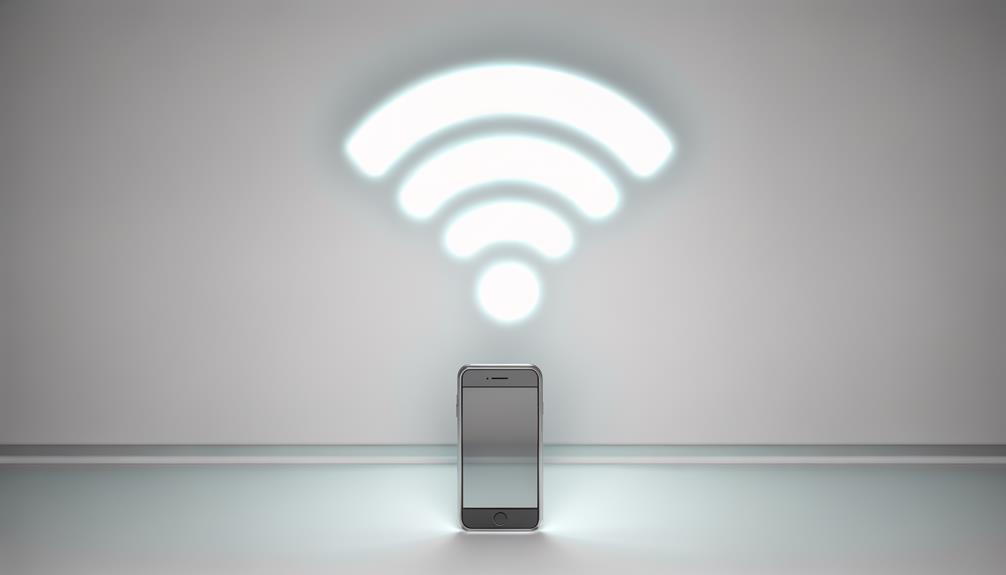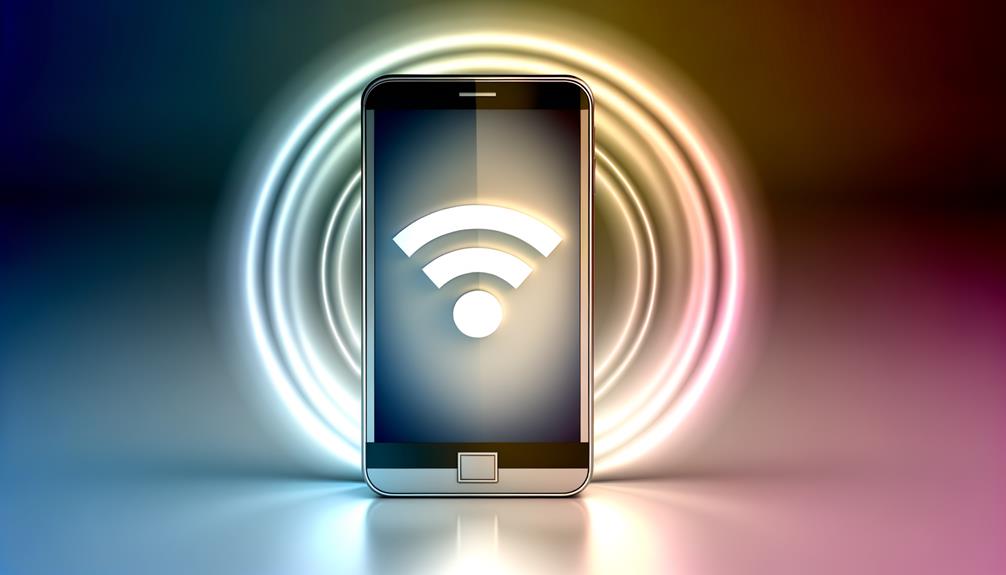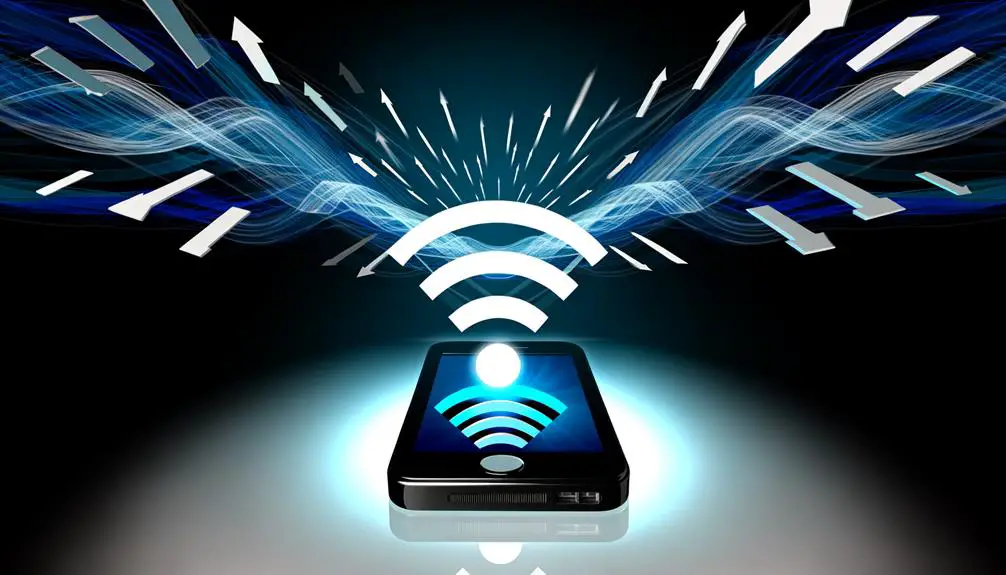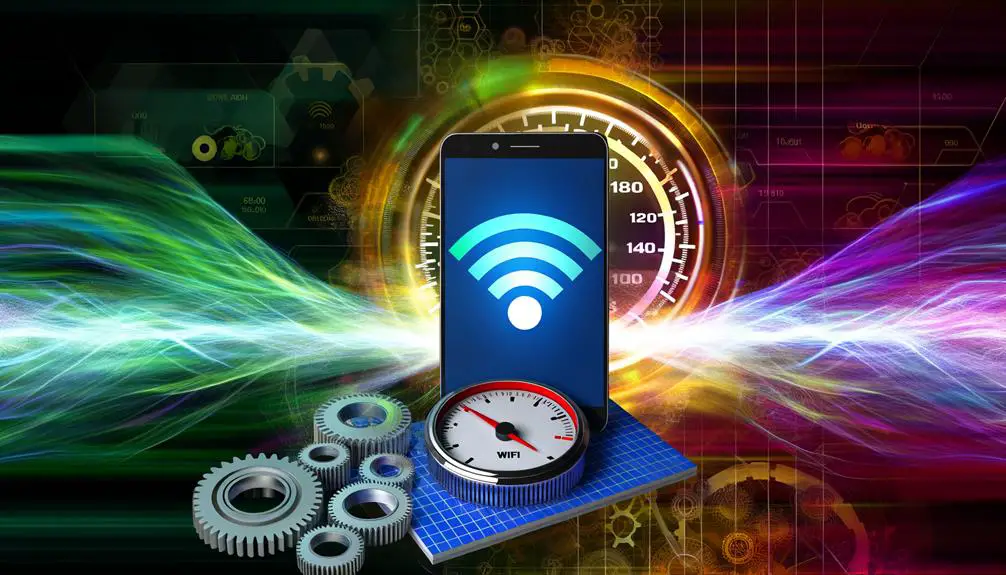Meaning of the Wi-Fi Symbol on My Phone
The Wi-Fi symbol on your phone serves as an indicator of your device's connection status, signal strength, and security level. Signal strength is depicted by bars; more bars indicate a stronger, faster, and more reliable connection.
Security is often represented by padlocks—closed implies encryption, while open indicates unsecured networks. Understanding these symbols is crucial for ensuring best internet performance and security.
Proper placement and setup can enhance signal quality and data transfer speeds. To gain a thorough understanding of managing and troubleshooting Wi-Fi connections on your phone, there are additional details available.

Key Takeaways
- The Wi-Fi symbol on a phone represents the device's connection to a wireless network.
- Bars within the Wi-Fi symbol indicate the strength and quality of the connection.
- More bars suggest a stronger, more stable Wi-Fi connection with faster data transfer.
- The presence of a padlock on the symbol signifies an encrypted, secure network.
- An open padlock or no padlock indicates an unsecured Wi-Fi network.
Wi-Fi Symbol Basics

The Wi-Fi emblem, typically portrayed as a series of concentric curved lines emanating from a central point, represents the presence of a wireless network connection. This symbol is universally acknowledged and indicates that a device, such as a smartphone, can link to the internet or local network without the need for physical cables.
The central point often symbolizes the wireless router or access point, while the curved lines denote the signal waves emanating from it. Understanding this symbol is vital for users to identify available networks and guarantee connectivity.
The Wi-Fi emblem's design is intentionally simple yet informative, encapsulating complex technology in a way that is accessible and easily understood by users across varying levels of technical expertise.
Signal Strength Bars
Signal strength bars on a phone's Wi-Fi symbol offer a visual representation of the connection quality, typically ranging from zero to full bars.
These bars indicate the strength of the signal received from the Wi-Fi network, with more bars suggesting a stronger and more reliable connection.
Understanding the correlation between bar representation and signal strength is vital, as it directly impacts the speed and stability of the network connection.
Bar Representation Meaning
Understanding the bar representation of Wi-Fi signal strength is essential for determining the quality of your wireless connection. The signal strength bars on your device provide a visual indication of the Wi-Fi network's performance.
Typically, more bars signify a stronger connection, while fewer bars indicate a weaker signal. Each bar represents a specific range of signal strength measured in decibels (dBm), which can vary from device to device.
For example, -30 dBm to -50 dBm usually corresponds to full bars, indicating excellent connection quality. Conversely, -70 dBm to -90 dBm corresponds to one or two bars, indicating a weak connection.
Understanding these bars helps in diagnosing connectivity issues and optimizing the placement of your router for better coverage.
Signal Strength Indicators
Recognizing the significance of the bar representation, it is essential to explore how signal strength indicators, or signal strength bars, provide valuable insights into your Wi-Fi network's performance. These indicators are visual cues on your device, representing the strength of the wireless signal received from the router. Each bar correlates with a specific signal strength range, offering a quick assessment of connectivity quality.
| Bars Displayed | Signal Strength (dBm) |
|---|---|
| 5 Bars | -30 to -50 |
| 4 Bars | -51 to -60 |
| 3 Bars | -61 to -70 |
| 2 Bars | -71 to -80 |
| 1 Bar | -81 to -90 |
This table elucidates the signal strength, with higher bars indicating stronger signals, ensuring reliable data transmission and smoother internet usage.
Connection Quality Impact
The number of signal strength bars displayed on your device directly influences the quality of your Wi-Fi connection, impacting various aspects such as speed, reliability, and overall user experience.
Higher signal strength bars generally indicate a robust connection, leading to faster data transfer rates and reduced latency. This guarantees smoother streaming, quicker downloads, and more stable online gaming experiences.
Conversely, fewer bars suggest a weaker connection, potentially resulting in slower speeds, frequent disconnections, and increased buffering times. Environmental factors, such as physical obstructions and electromagnetic interference, can also affect signal strength.
Understanding the correlation between signal bars and connection quality can help users optimize their Wi-Fi setup, ensuring they maintain a strong and consistent signal for all connected devices.
Connection Status

The connection status of a WiFi symbol with a phone is determined by two critical factors: the signal strength indicator and data transfer speed.
The signal strength indicator, often depicted as bars within the WiFi symbol, provides a visual representation of the quality of the connection.
Meanwhile, data transfer speed quantifies the efficiency and rate at which data is transmitted between the phone and the network, directly impacting the user experience.
Signal Strength Indicator
Understanding the signal strength indicator on your phone's WiFi symbol is important for evaluating the quality and reliability of your internet connection.
The WiFi symbol typically features several bars that represent the strength of the signal. More filled bars indicate a stronger connection, which generally translates to more stable and faster network performance.
Conversely, fewer bars suggest a weaker signal, potentially leading to intermittent connectivity issues and slower internet speeds.
Signal strength can be influenced by various factors, including physical obstructions, distance from the router, and interference from other electronic devices.
Regularly monitoring this indicator helps in identifying and mitigating connectivity problems, ensuring a more seamless internet experience.
Data Transfer Speed
Evaluating data transfer speed through the WiFi symbol on your phone is important for determining the current connection status and overall internet performance. Typically, the WiFi symbol provides visual cues regarding the quality and speed of the connection.
For instance, additional indicators such as arrows or varying shades within the WiFi icon can signify active data transmission or the relative speed of the network. Fast data transfer is often represented by solid, uninterrupted icons, whereas intermittent or slow speeds may be indicated by flickering or segmented symbols.
Understanding these nuances can help diagnose connectivity issues, optimize device performance, and make efficient use of network resources. This knowledge is particularly essential for activities demanding high bandwidth, such as streaming or large file downloads.
Security Indicators
Security indicators on a WiFi symbol with a phone often provide crucial information about the network's encryption status and connection safety. Typically, these indicators appear as padlock icons or specific acronyms such as WPA2 or WPA3, signifying different levels of security protocols.
A closed padlock symbolizes an encrypted connection, indicating that data transmitted over this network is protected against unauthorized access. Conversely, an open padlock warns of an unsecured network, posing risks to sensitive information.
Additionally, some WiFi symbols may include an exclamation mark, indicating potential security issues such as weak encryption or improper configuration. Understanding these security indicators ensures safer internet usage by enabling users to make informed decisions about connecting to various WiFi networks.
Data Transfer Arrows

Beyond security indicators, another important aspect of the WiFi symbol with a phone is the presence of data transfer arrows, which provide insights into the flow of data between the device and the network. These arrows, typically located near the WiFi icon, indicate whether data is being uploaded, downloaded, or both. Understanding these indicators can help users monitor network activity and troubleshoot connectivity issues. The table below elucidates the meanings:
| Arrow Type | Direction | Meaning |
|---|---|---|
| Upward Arrow | Upload | Data is being sent to network |
| Downward Arrow | Download | Data is being received |
| Both Upward & Downward | Upload & Download | Simultaneous data transfer |
These visual cues are essential for maintaining the best network performance.
Troubleshooting Tips
To effectively address connectivity issues, it is vital to follow a structured approach to troubleshooting the WiFi symbol with a phone icon. This symbol often indicates a problem with your network connection or device settings.
Begin by confirming the WiFi network is active and functioning correctly.
Next, validate your phone's software is up to date, as outdated software can cause connectivity issues.
Finally, consider resetting your network settings to resolve any configuration errors.
- Verify network status: Check if other devices can connect to the same WiFi network.
- Update software: Confirm your phone's operating system and apps are current.
- Reset network settings: Go to settings and reset network configurations to default.
Optimizing Performance

Having addressed connectivity issues, enhancing the performance of your WiFi connection is the next step to guarantee a smooth and efficient online experience.
Begin by positioning your router centrally to ensure optimal signal distribution. Utilize dual-band routers to differentiate between 2.4GHz and 5GHz frequencies, reducing interference and congestion.
Regularly update your router's firmware to benefit from security patches and performance enhancements. Additionally, managing network traffic through Quality of Service (QoS) settings can prioritize bandwidth for critical applications.
Employ WiFi extenders or mesh networks to cover large areas, minimizing dead zones. Finally, secure your network with strong encryption to prevent unauthorized access, which can impact performance.
Conclusion
The Wi-Fi symbol with a phone icon encompasses various elements, including:
- Signal strength bars
- Connection status indicators
- Security icons
- Data transfer arrows
Understanding these components is important for diagnosing and optimizing network performance.
Investigating the theory that clear visualization of these symbols can lead to better user comprehension and troubleshooting efficiency substantiates the idea that detailed and accurate iconography plays a pivotal role in enhancing the user experience and operational effectiveness of wireless networks.





